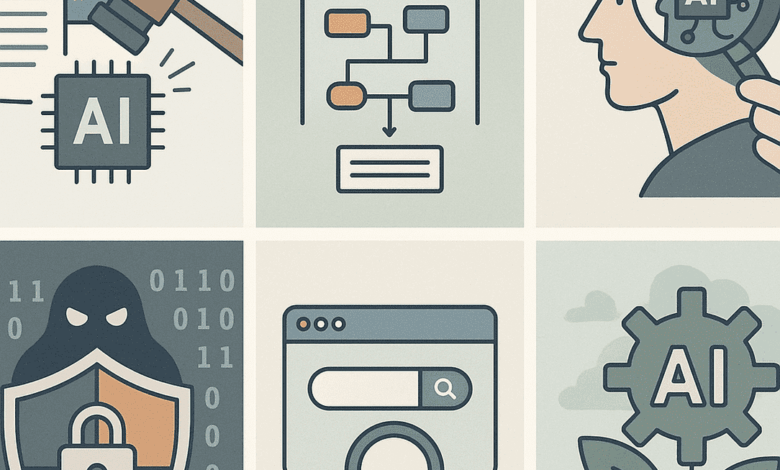
-
AI Regulation & Global Governance
Most founders treat regulation like a storm to wait out. I see it as a sorting mechanism, if your AI can’t survive scrutiny, it shouldn’t survive the market. The EU AI Act and U.S. directives aren’t threats; they’re the new baseline. They separate builders from opportunists and companies need to stop dodging compliance and started designing for it.
-
AI in Workforce Transformation
The real shift with AI isn’t about cutting jobs, it’s about reclaiming the ones we forgot. When admin work gets automated, people finally have time for the tasks that actually move the needle. For instance, in one clinic, if AI takes over their phones, they finally have time to clean up outdated records and engage with patients walking in. That’s what AI really unlocks: the breathing room to finally do things right.
-
Generative AI in Enterprise Workflows
Everyone’s chasing GenAI for the content fireworks, but the real gold is behind the scenes. It’s not about what the world sees, it’s about what your team no longer has to touch. No more blank-page dread for sales follow-ups, no more manual recap emails, no more daily status reports built from scratch. My startup has shaved 10 days off our deal cycle just by automating internal prep and nobody noticed, but that’s the point.
-
Trust, Bias & Transparency in AI Models
Let’s cut the nonsense, if your AI can’t explain itself, it shouldn’t be making decisions that affect people’s lives. “Advanced” isn’t an excuse for opaque it’s a liability. We work with clinics, and we didn’t even touch the model parameters, but surfaced why the AI made a certain recommendation and with that the trust in us jumped immediately. If your AI hides behind complexity, it’s not sophisticated, it’s unaccountable.
-
The Rise of AI Agents & Autonomous Workflows
AI agents aren’t coming, they’ve arrived and they’re not asking for permission. They’re booking appointments, managing approvals, escalating issues, quietly reshaping how work gets done. But here’s the thing: automation without intentional design isn’t progress, it’s drift and the best teams don’t just deploy agents, they design for accountability. They map decision boundaries, define fail states, and set the rules of engagement because autonomy isn’t the end goal, but effective delegation is.
-
AI-Driven Cybersecurity Threats & Defenses
If your cybersecurity stack doesn’t include AI, you’re not securing anything you’re just delaying the breach. Threat actors aren’t sitting around writing scripts anymore, they’re deploying deepfakes, spinning up voice clones, and automating phishing at scale. They’re not rare anymore. Companies are deploying AI not just for detection, but for anticipation: scanning behavioural patterns, auto-isolating suspicious network traffic, detecting synthetic media in real-time. The same tech used to attack is now the only tool fast enough to defend and if your cybersecurity doesn’t include AI, you’re not just behind, you’re exposed and unarmed.
-
AI & Sustainability: Hype or Reality?
Let’s be honest, AI has a sustainability problem, and hand-waving it away with ESG slides isn’t going to cut it. Training large models burns megawatts, running them at scale isn’t exactly carbon-neutral either, but here’s the flip side: AI is already helping companies make smarter, cleaner decisions and optimizing routes, predicting demand, minimizing waste. Logistics firms are slashing idle miles by using AI-powered dispatch (https://rtslabs.com/empty-miles-optimization). The real question isn’t whether AI is green, it’s whether we’re using it to be and if your AI strategy doesn’t directly reduce your footprint or your inefficiencies, it’s not sustainable, it’s just branding.
-
Synthetic Media and the Future of Content
We’ve crossed the threshold where most people can’t tell what’s AI-made and what’s human anymore. From virtual influencers to AI-generated news anchors, synthetic media is reshaping how brands, creators, and platforms operate. But here’s the catch: authenticity doesn’t vanish in this world, it becomes currency. The winners won’t be the ones hiding behind perfect avatars, they’ll be the ones saying, “Yes, this was AI and here’s how, and why.” If you’re building content without owning its origin, you’re not innovating, you’re gambling with trust and in a world this synthetic, trust is everything.
-
AI and the Future of Search
With Google shifting to AI summaries and answer-first formats, the old SEO playbook is getting thrown out. It’s not about stuffing keywords anymore, it’s about clarity, credibility, and speed. I didn’t need a background in SEO, I just needed to write like a human, for humans. And I think that’s where search is headed: away from gaming algorithms and back toward earning attention by being useful.
-
Edge AI & Real-Time Intelligence
We hear a lot about edge AI in manufacturing and logistics, but it’s the overlooked, everyday workflows where real-time intelligence quietly creates the biggest lift. Places where seconds mean dropped leads, missed revenue, or wasted staff time. Whether you’re spotting a defect on a conveyor belt or making a call that actually lands, the future isn’t just intelligent. It’s immediate.
Closing Thoughts:
AI isn’t some abstract future, it’s already reshaping how we work, decide, and communicate in real time. But the gap between what’s possible and what’s implemented is still wide. What we’ve seen, building from the ground up, is that real value comes from applying AI to the boring, broken, and overlooked parts of business. The phone calls no one wants to make, the workflows no one has time to fix, the insights that come too late. These aren’t moonshots, they’re solvable problems. and they’re where AI, when applied intentionally and transparently, makes the biggest impact.





